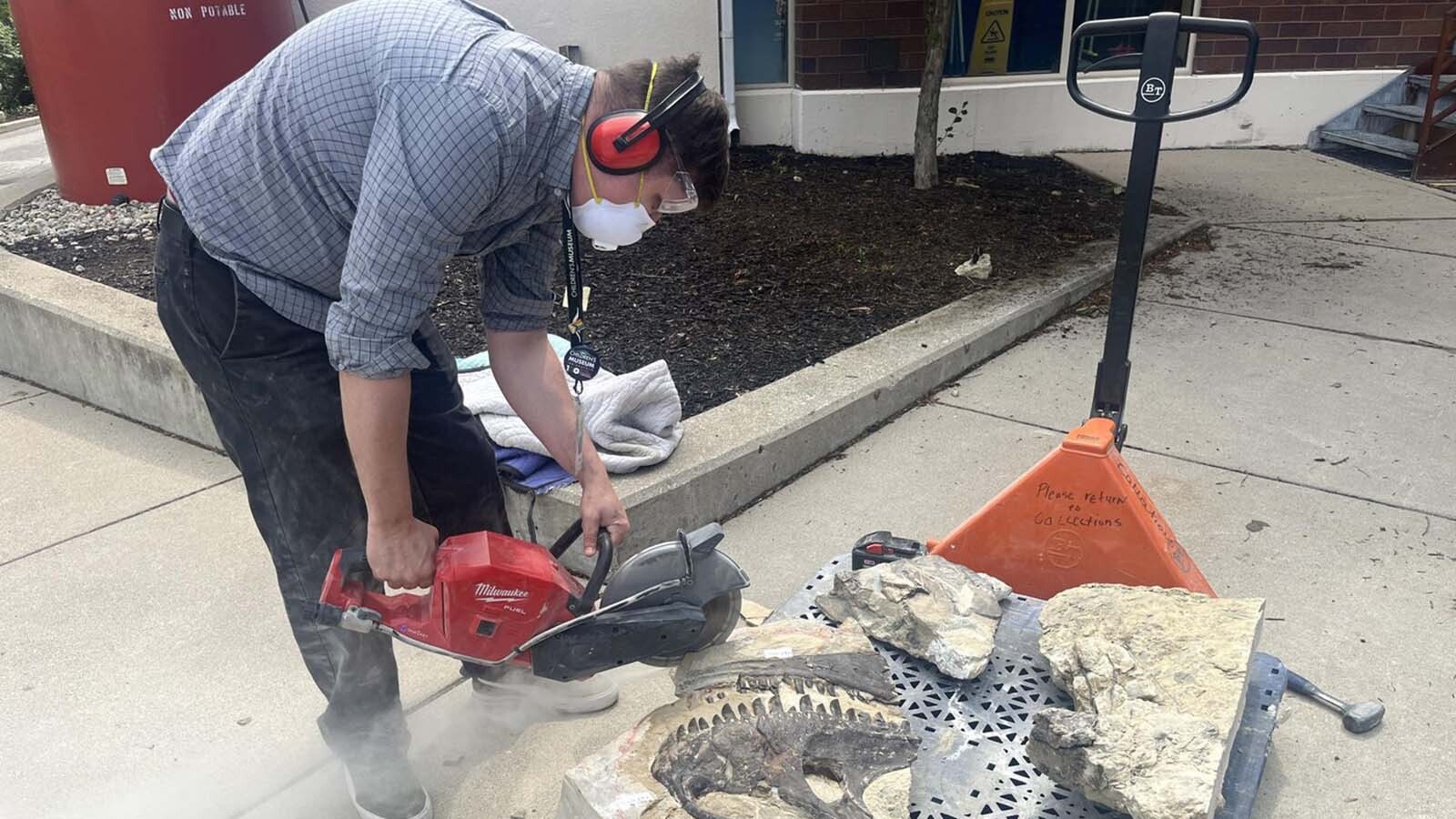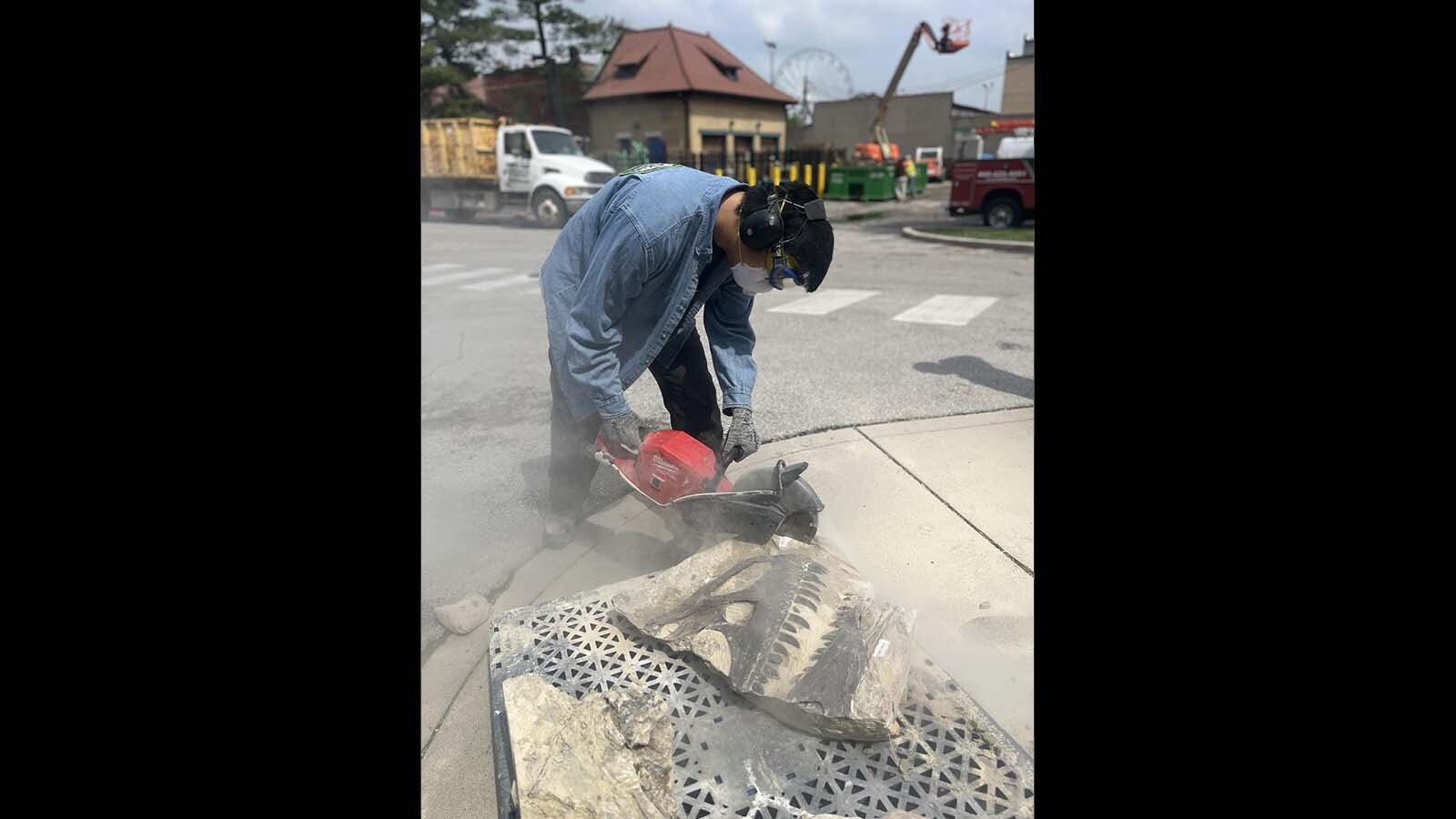A 150-million-year-old dinosaur had to lose thousands of pounds before getting a routine medical procedure. It wasn’t easy, but you can’t argue with the results.
The Children’s Museum of Indianapolis recently took two large sandstone blocks containing the articulated skull of an Allosaurus for a CT scan. This allowed paleontologists to examine the fossilized bones while keeping them in the hard, iron-rich sandstone that has preserved them since the Late Jurassic Period.
The skull is attached to a spectacular skeleton excavated from the Jurassic Mile, the museum's excavation site in the Morrison Formation near Lovell. Laura Rooney, curator of paleontology at the Children's Museum, still hasn’t gotten over how incredible this dinosaur is.
“Half that credit goes to the dinosaur, and the other half goes to our two preparators, Jorge Plata and Rachel Gray,” she told Cowboy State Daily. “They do miracle work.”
The Right Side Of Prehistory
When this Allosaurus died 150 million years ago, it collapsed on its right side and was covered by sediment that preserved its skeleton. Rooney said most of what they’ve uncovered from this dinosaur is from the right side of its skeleton.
“The right side is beautifully preserved, and the left side a little bit less,” she said. “At some point, shortly after this animal died, something sheared the left side of its body off. You can see something scraped up the left side of the body.”
Nevertheless, the preserved specimen includes a nearly complete skull and tail, the complete hips and legs, and significant portions of the torso and neck. They also found a string of the Allosaurus’s “belly ribs,” called gastralia, which were common amongst dinosaurs but are rarely found.
Once Gray and Plata exposed the right side of the Allosaurus's snout, the paleontological team at the Children’s Museum decided to do a CT scan of the blocks containing the front and back halves of the skull, preserved in two separate blocks.
Rooney said the preparators have meticulously worked on these blocks for over a year to prepare them for the procedure.
“Dinosaur skulls are incredibly delicate,” she said. “They’re made up of a lot of thin bones that can break pretty easily, and the rock surrounding them supports those bones. We wanted to get a CT scan to see inside the rock and ensure those bones are there before we do any more prep on them.”
But those blocks of rock fossils were heavy. A rock saw was needed to remove the excess rock surrounding the articulated skull – a delicate and anxiety-inducing process for any paleontologist.
“The blocks needed to fit inside the CT scanner, and we needed to be able to lift them onto the scanner,” Rooney said. “I'd say we removed a couple thousand pounds of rock from this thing before we could get it inside.”

Up To The Teeth
Once the blocks were scanned, two immediate revelations emerged: the skull is exceptionally well-preserved, and more rock must be removed.
“Most of the skull is still embedded in the rock,” Rooney said. “The rock containing the back half of the skull is very dense, so we’re still looking to peel back a bit more of that rock and hopefully do a second CT scan of that block.”
Gray and Plata have their work cut out for them, but their hundreds of hours of work on the snout were vindicated. The CT scan provided a glimpse inside the Allosaurus’s head, which Rooney was especially delighted about.
“Not only can we see the teeth that are exposed and visible to the naked eye, but we can see the new teeth growing right behind the ones that are currently exposed. That’s incredibly cool,” she said.
Unlike humans, dinosaurs constantly lost and regrew their teeth throughout their lives. An inside look into their jaws reveals batteries of teeth, lined up and ready to replace any tooth that broke off or fell out.
Rooney said seeing the already magnificent skull in cross-section was very exciting. Best of all, the actual fossils weren’t damaged or placed at risk during the process.
“Rachel and Jorge are clearing more rock from the back half of the skull right now,” she said. “We have a really good scan of the front half of the skull, and we hope to have an even better scan of the back half moving forward.”
A Halo Of Skin
Another exciting revelation from the Jurassic Mile’s Allosaurus is that the right half was so well-preserved that the fossils were covered with extensive patches of skin impressions.
Skin impressions surrounded the articulated bones of the dinosaur's hips, legs, and tail. This could be the most intact body impression of an Allosaurus ever found.
Recently, Rooney has been examining skin impressions found along the articulated tail. She described it as “a halo of skin” surrounding the dinosaur’s heavily muscled tail, which would have been used to balance and keep the dinosaur standing on its long legs.
“There’s a beautiful clay layer surrounding the tail bones,” she said. “We've opened up some new blocks of tail vertebrae, and there appears to be a halo of clay around those bones with skin impressions.”
To add more veracity to this discovery, the fossils were taken to another museum for examination. Rooney said she arranged for the skin impressions to be analyzed by a special technological tool at the Indianapolis Museum of Art at Newfields.
“They have an X-ray fluorescence machine at Newfields,” she said. “They usually use it for paintings at their museum, but we came to them with our dinosaur skin impressions.”
An X-ray fluorescence machine can be used to determine the elemental composition of different rocks. Rooney wanted to see if there was an elemental difference between the fossils and the surrounding rock, which could reveal if any organic material is preserved in the skin impressions.
That research is ongoing. Rooney said her Allosaurus art museum research is “coming along beautifully.”
Digital Necromancy
Now that Rooney and the paleontological team at the Children’s Museum of Indianapolis have CT scans of the delicate skull and its yet-to-be-exposed bones, they have the technology to resurrect a dinosaur without disturbing its rocky tomb.
The standard procedure for “Dinosaur Fossil Exhibits 101” is to remove all the rock encasing the fossil so that it can be studied and mounted for a museum exhibit. Because it’s so gorgeous as it is, Rooney and her team are pursuing a different path for their Allosaurus.
“We’re currently planning for the fossils themselves to likely stay in their original positions in the rock,” Rooney said. “They were found so beautifully arranged in the rock, and we would hate to lose that, and we think that's an excellent way to preserve that part of the story while also displaying it.”
Rooney expects the articulated sections of the skeleton to remain intact in their sandstone blocks. That way, they can create a dazzling display while retaining any scientific secrets that future paleontologists and technological tools might unlock.
Nevertheless, the museum wants to resurrect its Allosaurus. That’s where Rooney said the CT scans of the skull will be extremely useful.
“We're looking at some options for using 3D scanning, modeling, and printing to recreate a complete skeleton,” she said. “We can use the CT scans to create 3D models of the skull bones still embedded in the rock.
“When we reunite these pieces digitally, we can 3D print a complete skull, to scale, without taking anything out of the rock.”
Rooney envisioned that when the Children’s Museum unveils its Allosaurus display, the centerpiece will be a life-size 3D-printed replica of the dinosaur’s skeleton surrounded by cases containing the actual fossils, still articulated in the rock.
They’ll even be able to fill in the missing fossils from the left half of the dinosaur by mirroring their counterparts from the right half. Copy, Paste, Flip, and you’ve got two halves of a whole Allosaurus.
In Rooney's view, that exhibit would be the best of both worlds. However, there’s a lot of preparation and research to do before this dinosaur is resurrected in Indianapolis.
“Nothing’s set in stone yet,” Rooney said, “except for the Allosaurus.”

Millimeters Along The Jurassic Mile
Summer is the best time of year for paleontologists. It’s the field season, which means they can leave the stuffy air of their offices and laboratories behind for a few glorious weeks of sunburns, dust, and a lot of manual, back-breaking dirty work in the field.
The paleontological team at the Children’s Museum is preparing for their summer excursion to the Jurassic Mile, a square mile of rock exposures from the Jurassic Period near Lovell. That’s where they’ve found the articulated Allosaurus, several sauropods, and dozens of other fossils.
Rooney said the scope of this year’s expedition will be smaller — a lot smaller — than in previous years. There are plenty of big things waiting to be unearthed, but the team is prioritizing the search for the much smaller animals that lived in the heyday of Wyoming’s massive dinosaurs.
“When we were focusing on our bigger dinosaurs, we didn't spend as much time keeping an eye out for smaller things,” she said. “This year, we’re looking for the bones of reptiles, amphibians, fish, and small mammals that help us better understand the biodiversity of the site.”
One of the fossils recovered during a previous summer was a two-inch jawbone of a tuatara, a lizard-like reptile abundant during the Late Jurassic Period.
Rooney and Joseph Frederickson, lead paleontologist and manager of the museum’s Natural Science Collection, are hoping to find more fossils from these tiny reptiles.
“The Jurassic Mile is a pretty special place,” Frederickson told Cowboy State Daily in January 2024. “Everything from the tiniest little animals to the biggest ones in that ecosystem are preserved there. It’s an active research site, and quite a few active projects and papers are being worked on.”
Old And New
In the meantime, Rooney is working on a thorough description of the articulated Allosaurus. When published, it’ll cover every detail about the fossils, skin impressions, injuries, diseases and the rock preserving all this evidence, revealing information on the dinosaur’s life and death in Late Jurassic Lovell.
“It’ll be a whole description of the full skeleton of its geological context and determine whether it’s a currently known or potentially new species of Allosaurus,” she said. “We're looping in some research visits to a few museums during our trip to Wyoming to examine other Allosaurus specimens and compare them to ours, see what matches and what potentially doesn't.”
New technology is bringing old bones back to life in exciting ways, and Rooney is excited to see where her Allosaurus analysis leads her. There’s much more ground to cover along the Jurassic Mile, and everyone in Indianapolis is itching to get down to earth in Wyoming.
“Wyoming is a gorgeous place to work,” she said. “It's always fun to go, returning to our home away from home every summer. And this year, we’re hoping to find fossils that will help us put together the whole picture of the Jurassic Mile.”
Andrew Rossi can be reached at arossi@cowboystatedaily.com.





